Where Should The Madison High-Speed Rail Train Station Go?
Things look good for high-speed rail (110mph max speed) to be connecting Milwaukee and Madison courtesy of the American Reinvestment and Recovery Act. The state has actively drafted plans for the route and conducted environmental assessments to put Wisconsin as close to first in line as possible if and when capital funding were to become available. The stimulus package provides just the perfect opportunity.
While we won’t know if Wisconsin gets the funds until the final months of the year at the earliest, the announcement that Talgo will locate in Wisconsin and that $47 million in train equipment will be purchased from Talgo seems to indicate that Governor Doyle is either extremely confident we’ll get the money, or has received a verbal promise.
Milwaukee has recently invested in an excellent, centrally-located intermodal station that will provide an excellent hub on the line. The Milwaukee Intermodal Station itself is near a number of bus transit routes, will likely be served by the coming streetcar, and is even within walking distance of numerous destinations. It also features a lot of available, low-cost parking, which encourages many to take the Amtrak Hiawatha to Chicago from further off neighborhoods and suburbs. Also important, the development potential of the site is limited only the looming presence of Interstate 794, something that eventually be overcome.
Madison’s Plan
What does Madison have? Well at the moment, nothing. The plan is, however, for the stop to be located at the Dane County Airport in Madison.
What does the airport provide in terms of opportunity? For starters at least a $12 cab ride to the Capitol. Sure it provides parking, but at a cost greater than the parking in an urban location in Milwaukee.
There are few to no development opportunities at the airport itself, which of course enforces building height restrictions. The proposed station site is a big parking lot shared with the airport that can never be developed, and it is constrained by a creek and other wetlands. Without connections to an urban context or a street grid, walking to the station will never happen, and taking a bus isn’t much better. The current single bus route that serves the airport requires a transfer at Madison Metro’s North Transfer Point to reach downtown.
Yahara Station
Thankfully Madison-based urban planner Barry Gore provides a voice of reason and compromise between the WisDOT recommend to build the station on the mainline track at the airport versus bringing the train down Madison’s isthmus. Gore advocates for placing the station at Burr Jones Field. This location, near the intersection of First Street and East Washington Avenue provides roughly 950 feet of undivided land stretching over to East Johnson Avenue, which he claims is enough to site the 600-foot-long station platform. The site seems to be a logical compromise between an expensive downtown Madison station, and the remote Dane County Airport station, the Burr Jones Field stop, in-between Washington and Johnson on First Street, presents a wealth of opportunity.
1. Cost – A significant amount of track would have to be rebuilt to build a station closer to the Capital Square near the Monana Terrace convention center.
2. The fear of back tracking – With the of the Midwest Regional Rail Initiative proposing to have a line from Chicago to the Twin Cities, going too far into the isthmus would require back tracking out onto the mainline, possibly adding twenty minutes to the trip.
The Yahara Station addresses those points and more. The station wouldn’t require any back tracking, as the station’s location is on the track to go to the airport. In fact, Yahara Station’s location is 3.4 miles closer to Milwaukee, and correspondingly 3.4 miles closer to downtown Madison. According to Gore, if six trains run between Madison and Milwaukee a day as proposed the milage savings are incredible: Out to the airport and back is twice 3.4 miles, or 6.8 miles on every trip, 40.8 miles a day, 285 extra miles a week, 1244 miles a month, and 14,892 miles a year. That’s before considering the savings on buses, taxis, and personal automobiles driving to and from the site. Also considerable savings would be found in seven fewer crossing signals being forced to come down and block traffic on the train’s route to and from the airport.
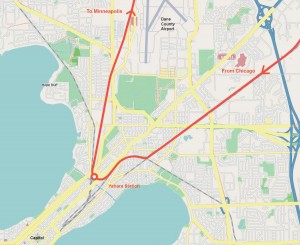
The route into Madison the train would take with either proposal. The turning point is the proposed location of Yahara Station.
Short term cost savings are found at Yahara Station by shaving off 3.4 miles of track that need to be rebuilt. Keep in mind that there isn’t station at the airport currently either, so both stations would require new construction costs.
Transit access is far superior at the Yahara Station site, with 14 bus routes within a block of the proposed station, and eliminating the need for a transfer to get downtown. The station is within cycle range of the UW campus, and offers a much cheaper cab ride to downtown.
The development potential of the Yahara Station site is nearly unlimited, compared to that of the airport site. There isn’t much around the site at the moment, but that isn’t a bad thing. Furthermore the developable parcels nearby would provide ample opportunity for firms looking to add locations in Madison to locate offices, as well as a logical spot to continue condo development as it spreads out from downtown. Perhaps most importantly to those that would drive to the station, the currently under-utilized land would drive parking costs down for those looking to drive to the train.
Potential Hold-Up?
What’s the hold-up with what seems such a logical plan? The proposal by Gore came late in the process, and WisDOT is reluctant to change their plan in a way that might jeopardize the potential $500+ million in stimulus dollars needed for the project. Gore understands the timing issue, but doubts that such a change would jeopardize the funds.
A simple compromise seems to be take the clearly better station as a back-burner plan, get the funds from the stimulus dollars, and then change the plans during the final design process. At this point no construction documents have been prepared for the project. Scared of the federal government taking the funds? Look at how long Milwaukee has held onto $91.5 million, which was originally $289 million for bus lanes on the interstate.
The airport plan will certainly hurt ridership on the line, and it’s fortunate that such a opportunity has presented itself in the Yahara Station to fix the potential misstep by WisDOT.
Why It Matters to Milwaukee
Why does this matter to Milwaukee? The station’s location significantly affects the mobility of travelers from Milwaukee and Chicago upon arrival in Madison. A more central location affords flexibility for spouses to work in different cities, greatly increasing the number of available jobs. It allows students to more reliably get from one city to the other. A downtown-to-downtown connection also greatly increases the ability for businesses to collaborate and grow in both cities.
Additional Documents
- Yahara Station Overview Document
- Yahara Station Detailed Plan
- Gore’s Letter to Representative Pocan
- Why the Airport Station Won’t Work
If you’re still not convinced, enjoy this story.
Fast forward to 2013.
President Barack Obama, fresh off a narrow re-election victory over Sarah Palin, is celebrating the opening of new Amtrak service between his hometown of Chicago and Madison.
Obama is riding with Gov. Jim Doyle and Mayor Dave Cieslewicz as the train rumbles past East Towne and under Wisconsin 30 and starts across East Washington Avenue.
“There’s the Capitol,” says Obama, looking out the window of a new Spanish-built Talgo passenger car. But instead of slowing, the train sweeps around the corner at First Street and starts heading back out of town.
“Wait a second,” says the confused president. “I thought you promised we’d stop in Madison for a beer?”
Doyle looks sheepishly at Cieslewicz before answering.
“We will eventually stop, Mr. President, but the new Madison train station is actually out at the airport,” an embarrassed Doyle explains. “We’ll have to get a ride back into town.”
“Forget that,” says Obama, grabbing his briefcase and ordering the engineer to stop at East Johnson Street. “I’m thirsty. You airport guys can meet me later.”
- Orientation of the station as well as likely land to be developed is pictured.
- Jim Doyle and Barack Obama, the golden ticket to high-speed rail in Wisconsin?
- The Milwaukee Intermodal Station is a welcoming hub for transit in Milwaukee.
- The tracks as they turn through Burr Jones Field.
- Land that may need to be partially claimed for a station platform. Clearly underutilized as its currently configured.
- The land where Yahara Station would go.


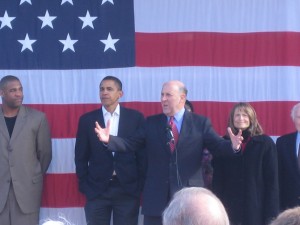
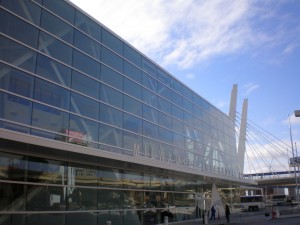
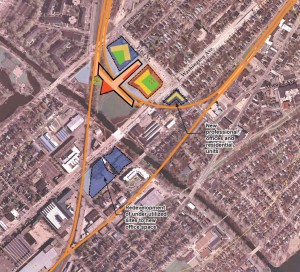
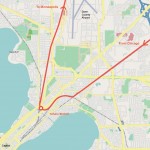
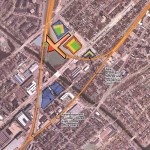
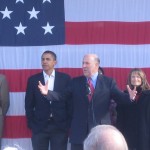
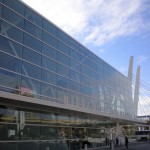
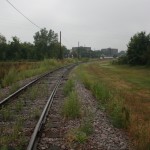
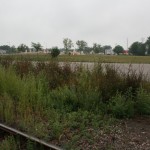
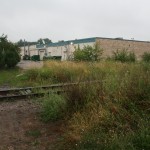







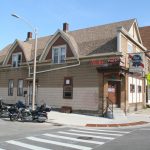











Nice post. I have a major fear that many cities considering high-speed rail will cave to the pressure and locate their station in a poor location because it is cheaper in the short-run. Once the line gets built, going back and relocating stations will be a serious challenge and ultimately prove much more expensive in the long-term.
Good reporting as usual, Jeremey. I’m with Rob — I too fear short term cheapness might win out. Yahara seems to solve the problems of backtracking while actually SERVICE the Madison population.
Why don’t they build the damn station in diamond Jim’s backside?? I ride the Hiawatha line several times a year, and I never see the trains more than half full! What the heck do they need a bigger train for? It will be under used and all the taxpayers will pay for this “service” for college kids and the occasional business traveler. It will never reach high speeds for any length of time, how can it with all the crossings, curves, and towns along the route? Why don’t they buy a fleet of taxi cabs, door to door service with less cost!! What a waste of 500+ million of our tax dollars! thanks gov. Doyle
Anyone got tube of toothpaste? i vomitted a bit in my mouth reading “Sarah Palin.”
MMM, i love how money has become THE most important uhh, “anything” in this country. If we invest in good station locations now no matter how much or little the cost, the paybacks will be larger as time progresses. Downtown to Downtown is best.
Yes paul, taxi cabs, to help NOT congest the roads, again. Less cost, because fuel is only going to get cheaper right?
We’re falling behind. One need only look to what the Chinese are doing to see how far we have to go. Fortune reports on the $50 billion that they are investing in high speed rail and the resulting 16,000 miles of track. (see http://bit.ly/1D3y5X).
As a Madison resident who is in Milwaukee once a week, I’d ride the train if it were convenient on both ends of the route, faster than driving and cheaper than driving and parking in Milwaukee. The airport location in Madison probably doesn’t meet these criteria. The Yahara Station is an improvement, but there still needs to be ground transportation linked into the station to make it convenient for a broader group of riders. There also needs to be some thought put into making it multi-modal like in Milwaukee. We’ll be losing the Badger Bus Depot, so there’s room for a bus terminal for Badger, Greyhound and Alco as part of the station plans.
Good post. Putting the station at the airport wouldn’t quite as annoying if the County/City was going to include a commuter rail stop there, but that isn’t in their initial plans.
But does anyone know the effects of monkeying with their submission at this stage? I think the stimulus funds have to be spent within a certain time frame; hence, the unwillingness to jeopardize them. Now, raising the possibility of relocating the station after you have the money in hand (or set aside) is something else entirely.
Also some additional facts just to round things out: the blue parcel north of the track is a city maintenance yard, the blue L on Washington and First is currently occupied by single-family homes. While a lot of that area is ripe for redevelopment, almost all the land on Washington west of the river is owned by one developer, who has been trying to re-use the existing ex-factory buildings. (At least two state agencies/departments are based there). Reportedly a lot of the land on the Isthmus may be polluted from the coal plant closer to the capitol, and might need additional work because it sits on a filled marsh. So, the redevelopment would be on a rather long time frame.
I agree that the airport location is a terrible choice.
But the author misses some major obstacles for the Yahara site.
First, the site is rather small, and is sandwiched between two of Madison’s primary east-west isthmus thoroughfares. Both of these crossings are at grade, and would be extremely difficult to bury or bridge. The traffic congestion caused by the existing trains using the route is already bad enough.
Second, like the airport location, the Yarhara project will have to deal with substantial wetlands and waterway restrictions. However, the real obstacle will be the Tenny/Lapham, and Emerson/East Neighborhoood associations. Neighborhood associations wield and inordinate amount of power over development projects in Madison, and will surely dramatically slow down project approval, if not kill it.
I also believe the author’s assumptions about parking fees to be wrong. Madison supports much higher parking fees than Milwaukee, and I should think, given how little space there would be to park at the Yahara Station, if anything, it would drive prices up. Despite building multiple large ramps and encouraging underground parking for new developments, parking costs have only gone up in Madison. Another flawed assumption concerns condo development. Most in real estate in Madison believe that the condo market is so oversaturated, that there will not be another major condo development for 5 to 10 years. And given that the proposed Yahara site is surrounded by single family homes and offices, there seems little opportunity for that sort of development.
Despite the cost and the extra few minutes of train travel, the Monona Terrace site makes the most sense. It’s proximate to everything important in Madison, and takes advantage of the city’s two most important archetectrual landmarks. Alternatively, using Madison’s proposed Central Park, or the existing Wisconsin and Southern railyards make much more sense.
@Joey I’ll let Jeramey respond to your individual points (as I’m not as familiar), but I wanted to say that neighborhood groups wield a lot of power in Milwaukee as well!
Joey – I agree – Why not put it on the tracks at the Monona Terrace? Build the station overhead and out over to the edge of Law Park – Just make John Nolen a longer tunnel – Blend the look with the FLW and add more parking/bus/taxi sites? Geez – everything would be downtown and we can keep our park space and all the downtowners in their condos would be able to get to Chicago and shop.
I agree with a lot of what’s posted above and think a downtown stop at or near Monona Terrace makes far more sense than either of the proposed stops. A quick check on Google Earth shows the distance between Monona Terrace and the Yahara stop/junction is just under 2 miles. Trains backing in and out along similar stretches of track to terminal stations is pretty common. Even if this stretch of track had to be traversed at a relatively low speed due to the numerous at-grade intersections, I can’t believe it would add more than a few minutes to journey time. This seems especially true when considering that a train would have to slow down to negotiate the sharp turn by the Yahara if the proposed route goes through.
One would think that ridership gains from actually going downtown would outweigh any ridership loss from extra journey time incurred, even if it was more than 10 minutes. Stopping at the airport represents a stealth journey time penalty (and cost penalty) for pretty much anyone traveling to or from Madison, except of course any Mehran Karimi Nasseri types living at Dane County airport.
A downtown stop would also be on land that’s actually desirable and would open up the possibility of having a developer finance its construction, provided they could build an office building, hotel, etc. above. It would also allow retail to be included at the station and possibly integrated into the downtown streetscape in order to serve travelers/locals and contibute to the station’s operating budget.
Thanks for all the comments. We had news today that the Tenney-Lapham Neighborhood Association board passed a resolution IN FAVOR of Yahara Station! So, in this case, the east side of Madison is standing up to say that they want this facility. The Campaign for Yahara Station hopes to meet soon with Emerson East.
As for the crossing of E. Washington and E. Johnson, please understand that if Amtrak has its station at the airport, then the train will be passing through Burr Jones Field on the same track, and will be crossing those two streets. WisDOT has expressed a concern that a train stopped at Yahara Station would keep the gates down, even if it was not going across E. Johnson, but returning to Milwaukee. Advanced intelligent transport systems, i.e., computerized traffic signal and gate control systems (or perhaps a human being in charge?) would be need to control gate movements, so that they are only down as needed. Actually, the fact that Yahara Station is sandwiched between these two arterials is a huge advantage in terms of access, especially for Metro Transit buses, with 5 routes on E. Johnson and 9 on E. Washington. And it also has great access from the interstate down Highway 30 to E. Washington.
I found Jeramey’s thoughts about parking costs very interesting. Parking for Amtrak in Milwaukee is only $3 per day. Parking in the economy lot at the Dane County airport is $6, $8 next to the terminal, and $10 in the ramp. There are acres and acres of land available right across E. Johnson St. in the WSOR yard for a private company to put up some fencing and a pay box and provide parking. But hopefully parking is only an issue for people coming from outside Madison. Access modes should be favored in order: Pedestrians, bicyclists, taxis, buses, drop off, and last, private vehicles needing parking.
In terms of multifamily housing, again, the whole E. Washington corridor is nearly vacant, and blighted All of it is in a new TIF district. Great sites, in need of redevelopment, are available right on the river. Mid-rise buildings will have views of both lakes. The market for new housing, new office buildings, and new commercial/entertainment will be greatly increased by the proximity to this transit station, which opens Madison to the Milwaukee, and more importantly, the Chicago markets. We need to think long term, the train won’t even start for 3 to 4 years, so if the condo and office markets stay soft until then that is not a huge problem. Our population will continue to grow. Set a growth boundary, conserve Dane County’s agricultural soils and redevelop the isthmus.
As for Monona Terrace, it should be clear by now that WisDOT will not now (or ever) bring any Amtrak trains further down the isthmus. Monona Terrace is not a good site for a train station. They looked at using the first floor of an old state office building on E. Wilson as the depot, but Wilson is one-way, no buses run on Wilson, and access is especially difficult from the west side. And, again Amtrak is not going to reverse the direction of those trains and add 20 minutes to the trip to St. Paul. Should Madison have two stations, one for Milwaukee riders and one headed to St. Paul? I don’t think so. It is confusing, and folks will miss the train, putting them at the wrong station when they catch the next one.
There is very little redevelopment potential at Monona Terrace, and what is there is being seized by hotels for conventioneers. Yahara Station, with much cheaper land values than the capitol square (right now anyways), creates an opportunity for downtown Madison to get back into being a private sector business office center, especially for bank and law firms with offices in Milwaukee and Madison. One hour service on the train will be very attractive.
Did I mention that a parking lot at the airport is not a good location for a train station?
Cheers.
@Barry Thanks for bringing this topic to our attention, it is important to those of us in Milwaukee that they get this right as well. Good luck and keep up the good work.
Barry,
I double checked with multiple people on the parking, it’s $5 at some lots, and $4 at others. It’s gone up since I actually last purchased it. Yet is still cheaper than the airport.
-Jeramey-
Hi Barry and others, I work for the California High Speed Rail Authority (HSRA) and I would just like to clarify one thing—our station platform lengths will likely be at least 400m (about 1315 ft) long with a desirable length of about 1380ft to accommodate our train sets. This depends on the rolling stock we purchase. I noticed you mentioned the length of trains in one of the PDFs, but, we will be linking many of them together.
I am not an engineer, nor am I familiar with Amtrak design, but one of our station design documents states that Amtrak typically requires platforms over 1,000 feet long. This could just be our California standard, I’m not sure.
I am not so familiar with Madison, so I don’t want to speculate on the location of your station because I see positives and negatives to both. Ultimately, you probably need to rely on ridership studies to determine the best location. I am a HSRA contact for transit-oriented development and sustainability issues and I’d be happy to discuss these topics with you. My number is 916-384-9523. I would put my e-mail out here but I fear SPAM.
As an out-of-state undergrad at UW-Madison in the ’90s, I took many flights out of MSN (Madison’s airport code) for Thanksgiving, Christmas, etc. The problem with MSN is that it is at the end of the line in the airline’s hub-and-spoke model. If you want to fly from Madison to the rest of the world, you will pay through the nose and have to connect through a messy hub along the way – usually O’Hare, Milwaukee, Detroit, Minneapolis, or St. Louis.
Airline passengers leaving from MSN don’t drive (or take a train) from Milwaukee, Minneapolis, or Chicago – those travelers can reach any destination they desire from their local hub. Instead, MSN serves south-central Wisconsin flyers by feeding them to O’Hare and other hubs on their way to the rest of the world. Officials should bear this dynamic in mind when determining station location.
Don’t get me wrong: Air-rail connections AT HUBS are VERY important pieces of HSR systems. HSR can help to reduce congestion and delays at major airports by doing the job that regional jets are doing today. HSR should connect downtown Madison to the cross-country and international flights leaving from O’hare and Milwaukee’s General Mitchell Field – not the other way around. However, the primary purpose of HSR should continue to be connecting regional population centers that are within a few hundred miles of each other.
Therefore, the argument that trains should stop outside of Madison to avoid a time-consuming reverse maneuver on the way from Chicago/Milwaukee to Minneapolis is a particularly irritating one. The vast majority of early adopters to this service will be those travelers between Chicago/Milwaukee and Madison because travel times on this segment will be in the sweet-spot of 2-3 hours. It’s 350 miles, as the crow flies, from Chicago to Minneapolis and the challenges of building true HSR through the Driftless Zone and the Mississippi River valley will have the project tied up in EIS for a long time. Even with the most optimistic estimates, it will be at least a decade before the line between Madison and Minneapolis is brought up to HSR standards and even then the trip time between Minneapolis and Milwaukee/Chicago will still leave many passengers opting for air travel. So to focus on the needs of Minneapolis-bound passengers at the expense of thousands of downtown Madison residents (many of whom live car-free) and employees is missing the forest for the trees.
Although the camera angles would like to suggest otherwise, Burr Jones Field is not “underutilized.” It is used by many sports teams. The small field is also part of our nearly extinct greenspace on the Isthmus. According to many neighborhood and city plans the area is severely deficient in greenspace. Building that close to the river would no doubt compromise the waterway.
The parking lot and strip mall next to the field, however, would be a similar location if it could be purchased for the site.
Didn’t Herb Kohl (I think he’s a senator now) have it planned that the grounds of the Kohl Center in Madison would double as a train station? That’s what I once heard.
“It will never reach high speeds for any length of time, how can it with all the crossings, curves, and towns along the route?”
They’re closing and bridging the crossings, and straightening the curves. Plus they’re using tilt trains which can go around curves at speed, comfortably, by banking into them.
The route is actually quite straight. And the towns pose no problem; buildings are not built that close to the tracks, so the trains can go fast right through town (provided there’s a bridge for each town to cross the tracks, and there aren’t actually that many towns which need one).
—
Regarding Monona, the problem is that the train is eventually planned to continue Milwaukee-Madison-Twin Cities — Madison isn’t going to be a terminal station. The route to the Twin Cities via the southwest side of Madison is not under consideration right now, probably for distance (it’s significantly longer) and environmental (straightening it involves building in wilderness, farmland, and wetlands) reasons. This means the train would to back out north to go to the Twin Cities. There are a *lot* of grade crossings on the Isthmus, and the train would have to run quite slowly through there, adding five minutes in *each direction*. In addition the train would have to be equipped to run “backwards” in push mode for half of its run (either Twin Cities-Madison or Milwaukee-Madison), or have a *very* slow reversing process adding another 10 minutes or more. So this would add 10-20 minutes to the Milwaukee-Twin Cities running time. That’s not considered reasonable. 5 minutes on Milwaukee-Madison might be reasonable, but that isn’t.
(Don’t underestimate the Madison-Twin Cities ridership potential, either.)
—
The one serious problem with the Yahara site is, quite simply: is it possible to make a nice long straight platform with reasonable curves at the ends? If not, well, that’s a problem. It deserves a short engineering study. If the curve can be pulled “inward”, away from Burr Jones Field, that will be a net improvement for greenspace as well.
I don’t get the “backing in and out” for the Monona Terrace problem. If Amtrak using the Tago train set as it is configured for the Cascade, then the train would be in a push-pull configuration. This is true for the Hiawatha train set as currently configured. The problems only arises if the Empire Builder is redirected through Madison … but why does that need to be done?
The Amtrak Cascade: http://www.youtube.com/watch?v=-1ZY6VLW7v0
I support the Yahara station concept, but Joe has a valid point. In Europe, many trains pull into stations and then pull out with a cab car or locomotive on the other end. All that is required is for the crew to walk from the one cab to the other. That disposes of a lot of the argument about the station needing to be on the through line. The bottom line though is that the Airport is not the right place. I agree that funding is critical and we don’t want to jeoperdize it, but putting the station at the Airport because of expensive parking, and some car rental counters is the wrong answer.
Take a look at the planned high-speed rail in California at http://www.infrastructureusa.org/california-high-speed-rail-a-visual-tour/. I think there should be the same for Wisconsin.
The fourteen local transit routes cited as being within a block of the Yahara station is misinformed. They do not all operate at the same time (peak hour only versus midday, etc.), some are limited stop service with no access near the station, and using many of them would require most riders to eventually switch buses somewhere else to reach their final destination. On weekends the service shrinks even further, only three routes within a block – and only hourly service on each of them.
On the other hand, a short distance north along the tracks, the transit system has a transfer point with twelve routes providing coordinating service, five of which also operate on weekends and two that run consistently every thirty minutes all the time. These routes would also provide a single seat ride for all of the north side of the City, both sides of the Isthmus, and major corridors heading both south and further west through town.
Great article! It would be ridiculous to not locate the Madison station within the City. Kinda the equivalent of the Simpson’s “escalator into the sky”, if you’ll recall that episode.
Let’s please get this right.
Well we have the funding, now this discussion becomes a little more real. I am all for the Yahara Station, as someone who has lived in Milwaukee Chicago and now Madison (again), I think it would only make sense to place a station closer to downtown for starters. When I lived in Chicago and Milwaukee I didn’t own a car so getting home for holidays was a chore to say the least. I relied on either the METRA to get me to Harvard IL and have someone pick me up there which totaled about 4 hours or a train to Milwaukee and have someone pick me up there (about 3.5 hours pending traffic) So I am really really excited to see this becoming real. Now as for the locations of all of these stops that I have had the pleasure of visiting I would say almost all of them were in a downtown setting minus some of the suburbs of Chicago where there really isn’t a defined city separated by country. And if we go back in history where do you find all of the old train stations? On the outskirts of town? Nope they are typically tucked into the downtown area of each city, in fact even Madison’s old station’s are pretty darn close to downtown. Here is a 1950 Rail map of Madison (http://img.photobucket.com/albums/v99/tim_archer/madrail/madrail7.jpg) So I think we need to go back and look at what has been done in the past to educate us about our future decisions, at least that is my philosophy. BTW here is a link to the whole article about Madison rail, where I borrowed the map link from http://powervoyeur.blogspot.com/2006/10/madrail-part-3-passenger-rail-in.html
Anyone who has driven in Madison knows that adding more train traffic through the Isthmus is a mistake. The Yahara plan has the high speed rail going through approximately 10 miles of affordable single family homes. I don’t think the people in these quaint neighborhoods feel the area is blighted. Madison is sprawling and there is no one location that will meet all passengers needs. Most of the high tech businesses are located on the West Side of town. Government and shopping are down town. The University and student population would not be well served by this location. Until the City develops a public transportation plan, it really doesn’t matter where the high speed rail station is located. Regardless of where the High Speed Rail staion ends up, the city of Madison will have to develop better public transportation around it so why not locate it in an area that won’t add further headaches to the Isthmus and take away one of the needed green areas, and significantly hurt the historical Starkweather-Schenk-Atwood neighborhood?
@Lou the Yahara plan is on the planned route.
Disappointing article. It’s a fallacy that the “Yahara Station” is an optimal proposal that meets the needs or delivers the benefits of a downtown location. Very obvious to fall into such simplistic thinking.
We have to have an airport link even if you build the First/Yahara station. So you’re wasting dollars and duplicating service, because they’ll have to build light rail to the airport anyway. So, thanks for
You sacrifice the redundancy built into an intermodal airport-rail station. Heavy snow, fog at O’Hare, air traffic controller’s union goes on strike, or a terrorist attack—switching to rail won’t be a problem. But here in Madison, everybody gets stranded &.or inconvenienced, and it’s no problem for you, because Madison’s parochial needs came before the region’s transportation needs.
Which leads to the fact that regional HSR is not built to serve Madison’s self-interest. It’s built to better serve travelers across the region. Not Todd McGrath. Not Madison. Where the HSR route slows down regional rail service, it has to be put back on a realistic route—and back to the ariport location.
Also, no one noticed you have to walk a full block from First Street to the Rail station???? NOWHERE do you have to do that at real railroad stations. At worst you cross a couple lanes of traffic to board the train. That set-up is masssively inconvenient, even amateurish. This location was selected to serve the developers of adjacent parcels, who aren’t responsible enough to move on projects on their own.
@ Dave Reid,
The Yahara Station is not on the planned route. Even a glance at wisdot’s map indicates the airport is accessed at Union Corners.
“We have to have an airport link even if you build the First/Yahara station. So you’re wasting dollars and duplicating service, because they’ll have to build light rail to the airport anyway. So, thanks for ”
Certainly the HSR can stop at the airport, but skipping the city misses out on the majority of the potential ridership. And even with a LRT line there is no duplication of service, as the systems serve different needs.
“You sacrifice the redundancy built into an intermodal airport-rail station.”
Redundancy, would be good, but that scenario is much much more the exception rather than the normal ridership.
Skipping the city will hurt ridership, as it adds more time to the travel.
Finally, the airport site simply doesn’t allow for economic development… i.e. TOD
@johnsturgen
http://twurl.nl/3riyo5
Page 3 “▪ Yahara Station is on the same, existing mainline track owned by WSOR as evaluated for the airport and Pennsylvania Ave. stations.”
Would it not be possible to build a station under the Monona Terrace complex?
@Scott I think the issue is cost, and transit time..
Scott,
If you look at the following map, you will see why the route past the Monona terrace would not work for a future extension to the twin cities by going past Monona terrace the rail line would not be able to be extended to the twin cities without requiring the train to run on a longer route, or backtrack which would need significant improvements to make it even suitable for basic low speed passenger rail. In addition any improvements to a route that runs past Monona Terrace to Minneapolis would not benefit the existing Empire Builder rail line and would probably need a lot more of a substantial Environmental Impact Study(EIS) than if it was to follow on a route similar to the Existing lines which could be just upgraded with a Finding of No Significant Impact(FONSI) statement saying that there would be a lot less of an environmental impact because it would be on existing passenger rail tracking.
http://www.dot.wisconsin.gov/localgov/docs/railmap.pdf
I am new to the conversation, but think I might have some useful insight. The HSR will be used to support intermediate range travelers, up to around 500 miles. Longer distances will still be serviced by air transit. These longer distance travelers are expecting longer travel times and transferring between transportation types, so having to take a light rail to the airport is not a big deal.
The HSR will get the most ridership by connecting urban centers. So the station should be located as close to the center as logically possible and be designed as an inter or multi modal station where people have the choice of what transit to take. I think a light rail around Madison connecting to this station is a good idea because once people arrive from the HSR they feel that they have arrived in Madison. Adding an extra trip from the airport is not the arrival experience that encourages ridership in the intermediate distance; people will drive in order to feel like they arrive where they need to be.
I am not filmier with the location that Mr. Gore proposes, but local people usually know best. The train platforms will need to be on the order of 1400 feet long for HSR, but a lot of these problems can be solved with creative solutions.
What the WDOT should really do is support a design competition for the new station to bring in ideas and spur conversation about the best solution.
@Matt Welcome to the conversation…
http://www.notrain.com/
WE DON’T WANT THIS STUPID AS$ TRAIN! $817 Million to build? Unemployment is in the double digits, the state is going bankrupt WTFAWT????????????????????? Idiots who want this train better pony up more cash to support it once they realize it won’t be profitable.
Yes! @No Train just made my day. Utilizing all caps to yell!, swearing, tons of questions marks, and some name calling ..nice…. that’s great.
@PS If anyone is seeing this article for the first time now, we of course love the downtown Madison location for the stop.
@No Train So, because “unemployment is in the double digits,” upgrading and improving the state’s infrastructure, which will put people to work in the short-to-medium term, and improve conditions for economic growth in the long term is a bad idea? I just don’t follow.
I think they should definitely put the station near the Capital. If I had to take a cab after riding the train to get to downtown Madison I’d be much less enthusiastic about using the train. Convenience is key! Also Eric I agree with you. And I think people need to realize that there are too many people living on this planet and we have limited resources. We need to change in order to adapt to our changing world. This train is a step in the right direction… less cars, less traffic, less emissions, increase jobs, eventually the train would help circulate money into the economy, easier commute for students, and could even decrease deaths on Wisconsin roads etc. I don’t see how it is a bad idea.
@Sara S This article came out before the Capital was offered as a viable option, generally it had been said it couldn’t be done so this was an option to get close. Now that is is at the Capital and apparently that can work, yes 100% we like it there, I look forward to biking to Intermodal, catching the train to the Capital and then biking around Madison!